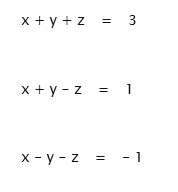System of Equations theory II
System of Equations
This theory about System of Equations is the continue of the previous post “System of Linear Equations theory”
Gauss method:
Gauss method is to transform the given system into an equivalent system. To do this we take the extended matrix of the system and by elementary operations with their ranks, we transform it into a higher (or lower) triangular matrix. Thus we obtain an equivalent system to the start and easier to solve it:
It is similar to the reducing method, because it operates with equations, as it is done in the reduction method, but you save writing the unknowns because when coefficients of the same unknown go always in the same column, you know all time which is the unknown to which multiply.
Example:

Bioprofe | System of Equations theory II| 01
We form the augmented matrix of the system:

Bioprofe | System of Equations theory II| 02
If to the second and third row we subtract the first, we get:

Bioprofe | System of equations theory II| 03
If now we exchange the second row from the third, we obtain the following upper triangular matrix:

Bioprofe | System of equations theory II| 04
Which it is the augmented matrix of the following equations system:

Bioprofe | System of equations theory II| 05
We solve the third equation and we see that:
Bioprofe | System of equations theory II| 06
Substituting into the second equation the z value obtained and we obtain the value of the “y” unknown:
Bioprofe | System of equations theory II| 07
Substituting the values in the first equation we get all the unknowns:

Bioprofe | System of equations theory II| 08
SOLUTION:
X= 1; y= 1; z= 1
Inverse matrix method:
It is similar to Gaussian elimination process, since the system is written in matrix form:
A · X = B
If A-1 exists, that is, if A is a square matrix determinant is not zero, then we can multiply all previous equality by A-1 to obtain:

Bioprofe | System of equations theory II| 09
which it is the solution of system of linear equations of A coefficient matrix and B matrix independent terms, which it is already resolved following the steps of the Gauss method.
Cramer rule:
This rule is a method of solving linear equations systems that can be used when the coefficient matrix of the system is square (equal number of unknowns and the number of equations) and nonzero determinant.
When the system of linear equations satisfies the above conditions, its solution is given by:

Bioprofe | System of equations theory II| 10

Bioprofe | System of equations theory II| 11

Bioprofe | System of equations theory II| 12
Example:

Bioprofe | System of equations theory II| 13
We can apply Cramer rule for its resolution:

Bioprofe | System of equations theory II| 14
SOLUTION:
X= 1; y= 1
You can download the App BioProfe READER to practice this theory with self-corrected exercises.




